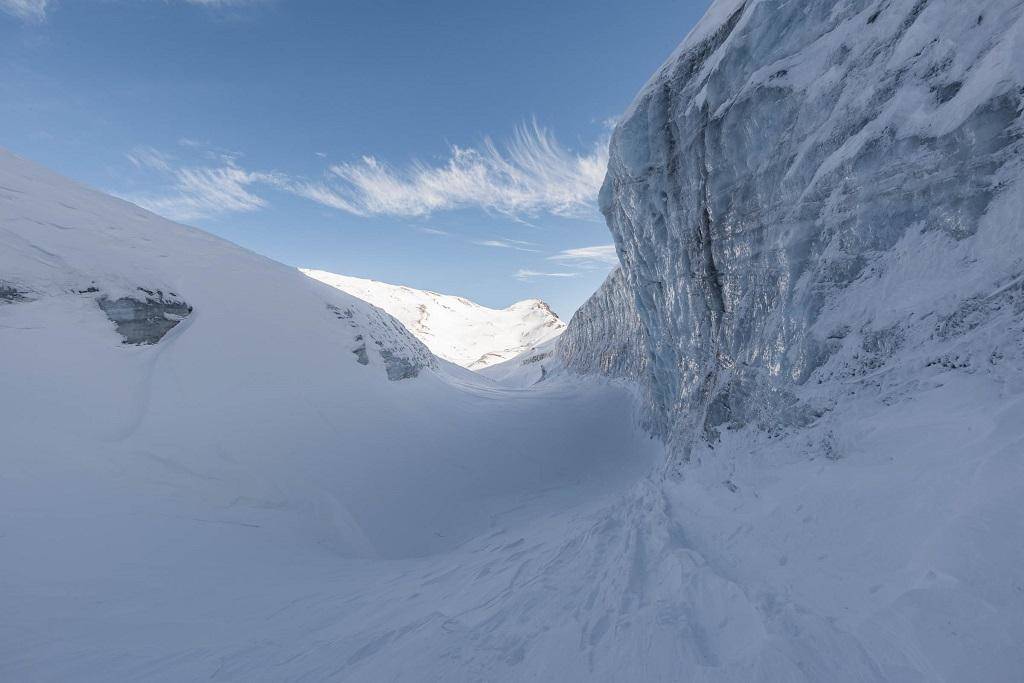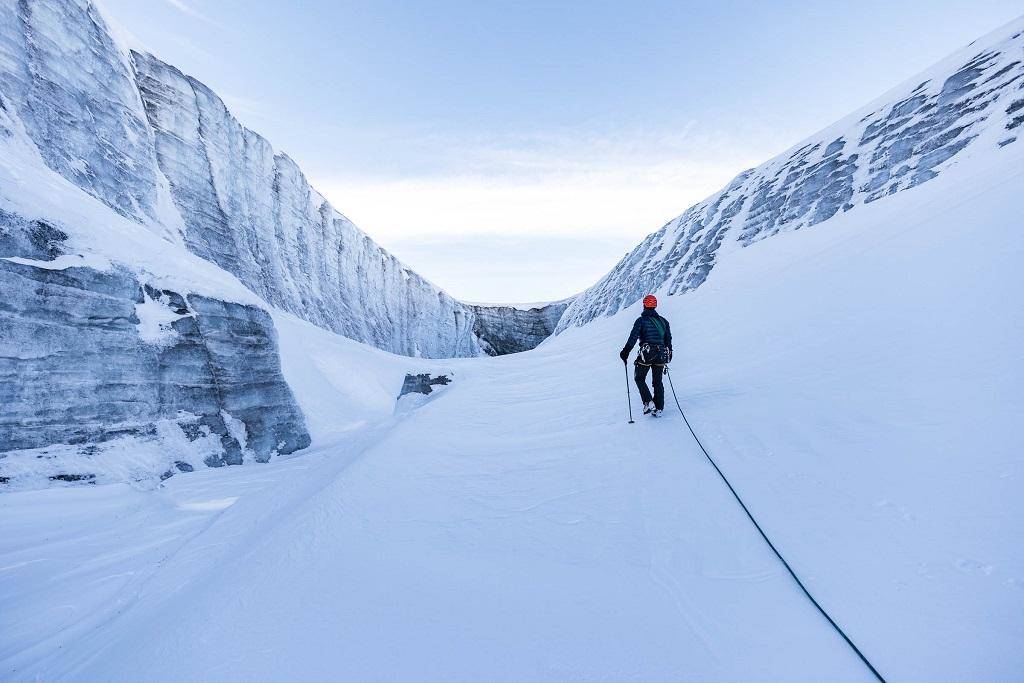Into the deep
Journey to the heart of a glacierInto the deep
VIDEOJourney to the heart of a glacier
360°The end of the gorge: an ice wall with arches underneath it. Could this be the entry?
That glaciers have their own, hidden, lives has been known for a long time. In summer, for example, we can see melt water disappearing in deep holes, but nobody really knows what happens next. The fact that the water eventually flows out at the end of the glacier suggests that there must be a well-connected canal system somewhere down there. Fred and Hervé want to do what has never yet been done: they want to inspect the whole labyrinth, in all its dimensions. And if it’s obvious that these two big men will move a lot less graciously than the tiny glacial streams, they are determined not leave a stone unturned in exploring the underworld. We have the chance to go with them.
360°Suddenly, there is a 180-degree curve. Even glaciologists can only assume the reason for the change in direction.
VIDEOThe cut-and-closure-process at the entry could be an explanation for how this structure was created. Up until now, this process has mainly been observed in Arctic glaciers.
360°Nighttime on the Plaine Morte. According to models, the white plane will be completely gone by 2090.
VIDEOIn the course of the summer, the Lac des Faverges fills up with meltwater.
360°A round hole filled with snow, however, this time it is not blocked.
360°At first, the entry is narrow but then a shaft opens up. There is an echo.
360°Faint light shining in from above: the UFO lid. A lake opens up before us. Water blocks our path.
Finally, we reach a space as big as a chapel. A small lake appears in front of us. Far above, we can see the light shining through the UFO lid. We are probably the first people ever to enter this space. On the walls, we can see fragments of ice plates indicating that the water level must have been much higher not too long ago. Some of these ice plates are as big as tables and are towering menacingly above us. We wonder whether our combined body temperature could generate enough heat to make them tumble down. We decide not to hang around too long.
At the end of the hall, we can see a continuation of the tunnel. The corridor disappears into the water. “Next time, we should bring wetsuits,” Hervé says to Fred. They are serious. We can sense that they feel at home down here. No adversity would make them give up on their dream. We, however, have reached the end. And who knows what it will look like next year…
Picture GalleryJourney to the heart of a glacier
Credits
Credits
Dominik Osswald, Tamedia
Programming and storytelling
Kaspar Manz und Marc Brupbacher, Interaktiv-Team
Photography, 360°‑panoramas
Urs Wyss, Christian Mülhauser
avocado360
Olivier Christe
Drone pictures
Christian Mülhauser
Videos
Dominik Osswald
Christian Mülhauser
Olivier Christe
Animations
Pierre Tschopp
Ursula Ritter
Geotest monitors the Lac des Faverges and supplied us with data for the 2nd animation
Illustrations
Jürg Candrian
Advice 360°‑picture production
Janina Woods, Sebastian Tobler
ateo GmbH
Gear sponsors
Haglöfs
Bächli Bergsport
Thanks to
Frédéric Bétrisey
Hervé Krummenacher
Matthias Huss, Glaziologe ETH und Uni Fribourg
Kathrin Naegeli, Uni Fribourg
Daniel Tobler, Geotest
Bergbahnen Crans-Montana
swisstopo
swissinfo Produktion
Luca Schüpbach
Marcel Stauffer








































































 Into the deep
Into the deep
 Plaine Morte (‘dead plain’) Glacier
Plaine Morte (‘dead plain’) Glacier
 The end of the gorge: an ice wall with arches underneath it. Could this be the entry?
The end of the gorge: an ice wall with arches underneath it. Could this be the entry?
 The beginning of winter this year is cold and dry
The beginning of winter this year is cold and dry
 The entry into the horizontal corridors is tiny. Getting through demands some digging.
The entry into the horizontal corridors is tiny. Getting through demands some digging.
 Suddenly, there is a 180-degree curve. Even glaciologists can only assume the reason for the change in direction.
Suddenly, there is a 180-degree curve. Even glaciologists can only assume the reason for the change in direction.
 The cut-and-closure-process
The cut-and-closure-process
 Walking inside a glacier was considered taboo for a long time
Walking inside a glacier was considered taboo for a long time
 Nighttime on the Plaine Morte. According to models, the white plane will be completely gone by 2090.
Nighttime on the Plaine Morte. According to models, the white plane will be completely gone by 2090.
 The Plaine Morte Glacier has retreated more than any other glacier in the Alps
The Plaine Morte Glacier has retreated more than any other glacier in the Alps
 The lake basin is dry. The trough turns into a gorge.
The lake basin is dry. The trough turns into a gorge.
 In the course of the summer, the Lac des Faverges fills up with meltwater.
In the course of the summer, the Lac des Faverges fills up with meltwater.
 An ice wall marks the end. What is beneath it?
An ice wall marks the end. What is beneath it?
 A round hole filled with snow, however, this time it is not blocked.
A round hole filled with snow, however, this time it is not blocked.
 At first, the entry is narrow but then a shaft opens up. There is an echo.
At first, the entry is narrow but then a shaft opens up. There is an echo.
 We have reached the water. We carefully move along the ice. Ice floes are swimming in the corridor.
We have reached the water. We carefully move along the ice. Ice floes are swimming in the corridor.
 Faint light shining in from above: the UFO lid. A lake opens up before us. Water blocks our path.
Faint light shining in from above: the UFO lid. A lake opens up before us. Water blocks our path.
 Journey to the heart of a glacier
Journey to the heart of a glacier
 After abseiling for about 50 metres, we hit snowy ground. Now we enter darkness.
After abseiling for about 50 metres, we hit snowy ground. Now we enter darkness.
 Abseiling into the moulin. In summertime, a waterfall thunders down here.
Abseiling into the moulin. In summertime, a waterfall thunders down here.
 Farther down, the snow almost prevents us from continuing. We need to do some digging.
Farther down, the snow almost prevents us from continuing. We need to do some digging.
 Through a small hole, we finally reach a horizontal gallery. At the beginning, walking upright is still possible.
Through a small hole, we finally reach a horizontal gallery. At the beginning, walking upright is still possible.
 But soon, we have to revert to crawling on all fours on the ice.
But soon, we have to revert to crawling on all fours on the ice.
 It’s pitch dark. It is a comfortable 0 degrees. Cave researcher Frédéric Bétrisey explores the way ahead.
It’s pitch dark. It is a comfortable 0 degrees. Cave researcher Frédéric Bétrisey explores the way ahead.
 The corridors are filled with a snow-water mix, which is still liquid in autumn. We crawl underneath it.
The corridors are filled with a snow-water mix, which is still liquid in autumn. We crawl underneath it.
 Base camp on the glacier. It’s significantly colder here than inside the caves. Minus 25 degrees.
Base camp on the glacier. It’s significantly colder here than inside the caves. Minus 25 degrees.
 Strategy consulting in the kitchen igloo. Will we be able to find the drain?
Strategy consulting in the kitchen igloo. Will we be able to find the drain?
 The gorge in the ice. This is where the lake basin drains and where the water has cut deeply into the ice. We assume the drain to be at the end, however, it is covered in snow.
The gorge in the ice. This is where the lake basin drains and where the water has cut deeply into the ice. We assume the drain to be at the end, however, it is covered in snow.
 We find another hole in the gorge. Is this leading anywhere?
We find another hole in the gorge. Is this leading anywhere?
 Indeed – the snow that fell at the beginning of winter did not block the hole entirely.
Indeed – the snow that fell at the beginning of winter did not block the hole entirely.
 A dark shaft leads into darkness.
A dark shaft leads into darkness.
 Suddenly, we see light coming in from above. We assume that we are inside a covered moulin.
Suddenly, we see light coming in from above. We assume that we are inside a covered moulin.
 We have reached the water. We carefully move along the ice. Ice floes are swimming in the corridor.
We have reached the water. We carefully move along the ice. Ice floes are swimming in the corridor.
 The faint source of light is above us. The ceiling does not seem to be solid. The corridors disappear in the water.
The faint source of light is above us. The ceiling does not seem to be solid. The corridors disappear in the water.
 The team.
The team.